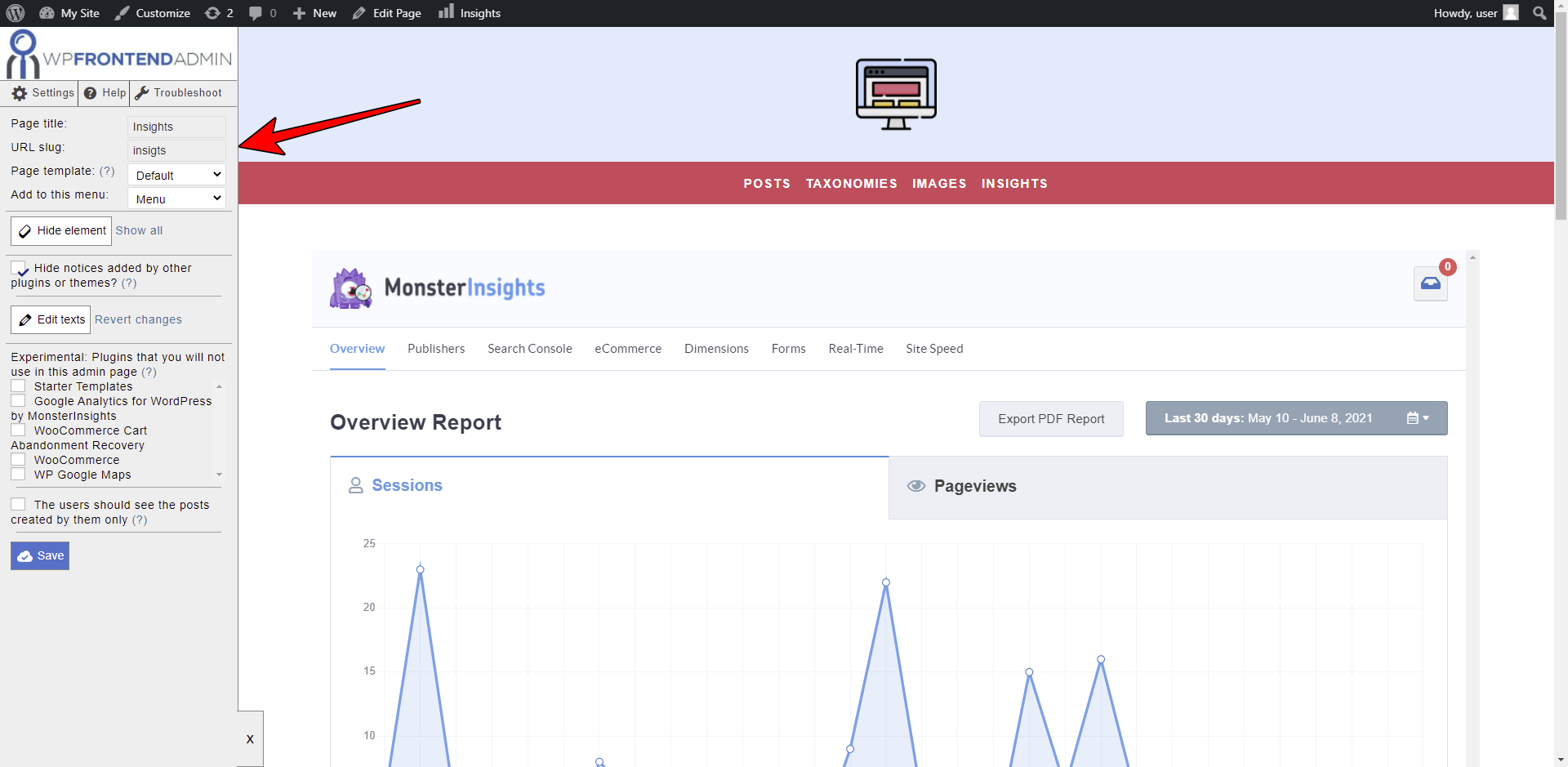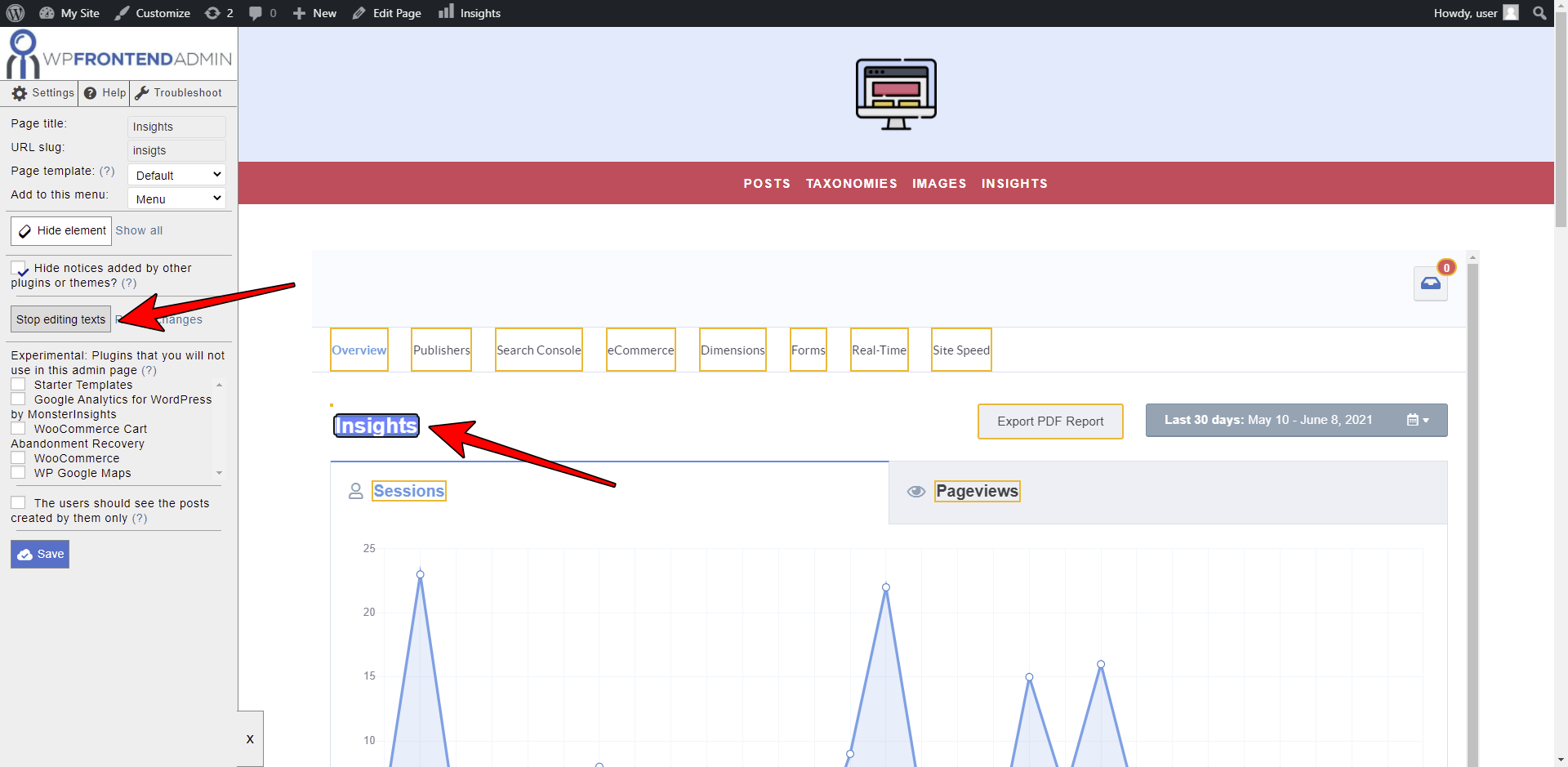In this tutorial, we’ll show you how to allow authors to view MonsterInsights reports on the frontend. Users will be able to track the page views without having to use the wp-admin dashboard.
We have a tutorial to show you how to allow authors to create and manage posts on the frontend. And here we show you how to allow them to view the analytics reports on the frontend. You can integrate these two pages to a frontend dashboard for WordPress.
Besides the MonsterInsights – Google Analytics Dashboard for WordPress (Website Stats Made Easy) plugin, we’ll need the WP Frontend Admin plugin.
It allows you to display any wp-admin page on the frontend to create beautiful frontend dashboards and web apps based on WordPress plugins. You can build complete platforms and earn a lot of money.
You can try the premium plugin on your website for free for 7 days.
After installing the WP Frontend Admin plugin, you need to follow these simple steps to display the MonsterInsights reports on the frontend and allow your authors to view them without having to use the wp-admin dashboard.
1- Display the MonsterInsights Reports on the frontend
To create a frontend page to display MonsterInsights reports in the frontend, you would normally have to have some experience in web development and programming. However, WP Frontend Admin allows you to display Analytics reports on the frontend with a single click or a simple shortcode, without needing to know anything about programming.
Go to Insights > Reports and click on View on the frontend.
It’s important to mention that you can use any of the following WordPress page builders to create a frontend page to display the MonsterInsights reports on the frontend.
- Elementor
- Visual Composer
- Gutenberg
- Divi
- Beaver Builder
- WP Page Builder
- Page Builder by SiteOrigin
- Oxygen
- Live Composer
- Brizy
- Etc.
You just need to use the following shortcode on the page content to display the MonsterInsights reports on the frontend:
[vg_display_admin_page page_url="admin.php?page=monsterinsights_reports#"]
Once you’ve entered the shortcode on the page content, you need to click Preview to view the MonsterInsights reports on the frontend and configure the page. You need to do this because WP Frontend Admin doesn’t show admin content in editor mode, just in preview mode.
2- Select your frontend MonsterInsights page’s info
Once you’re able to view the MonsterInsights reports page on the frontend, you can use the Quick Settings panel that WP Frontend Admin displays on the left side of the screen. This panel contains all the tools you need to configure your frontend pages.
You can start configuring your frontend MonsterInsights overview page by selecting the following information:
- Page title
- URL slug
- Page template: You can select the Default template to use your theme’s appearance.
- Add to this menu: You can add this page to a nav menu. For example, if you’re creating a basic dashboard for authors, you can add all the dashboard pages to this nav menu.
3- Hide any unnecessary elements from your page
WP Frontend Admin allows you to hide any unnecessary elements from your frontend MonsterInsights overview page. For example, if you don’t want the Monster Insights logo to appear on your site, just click on the Hide element button and then click on the element you want to hide. It’s that simple, and it will help you completely customize the page’s appearance.
For example, you can hide these elements:
- The Monster Insights logo
- If you use the free version of the MonsterInsights plugin, you can hide any buttons asking you to upgrade to the pro version. You can also hide the Publishers, Search Console, eCommerce, Dimensions, Forms, Real-Time tabs.
Besides, you can tick the Hide notices added by other plugins or themes checkbox to prevent users from seeing WordPress notices on the frontend.
4- Edit any texts on your frontend Analytics reports page
Besides hiding any unnecessary elements, you can edit any texts on your frontend Analytics reports page. This is really useful to simplify your pages and customize them even more.
Just follow these simple steps to edit the texts:
- Hit Edit texts.
- Change all the texts you want.
- Hit Stop editing texts.
5- Disable any unnecessary plugins and publish
We’ve added an option that enhances site performance by allowing you to deactivate the plugins that won’t be used by this frontend page. In this case, you can disable them all, excluding the Google Analytics for WordPress by MonsterInsights plugin. This plugin needs to be active.
Once you’re done configuring your frontend page, you need to hit Save to publish the page.
6- Allow authors to view MonsterInsights reports on the frontend
Something important to mention is that only the users with the monsterinsights_view_dashboard capability will be able to view the Analytics reports on the frontend. Therefore, you can follow this tutorial to learn how to grant that permission to the users with the Author user role.
Once you’re done with these six steps, this is what the authorized users will see on the frontend MonsterInsights page:
As you can see, displaying the Google Analytics reports from the MonsterInsights plugin is not a problem if you use the WP Frontend Admin plugin.
You can try the premium plugin on your website for free for 7 days.







